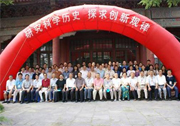| 中文题目: | 同理异法——《泰西水法》与潮汐问题 | ||||||
| 英文题目: | Shared Ideas, Divergent Approaches: The Hydromethods of the Great West (Taixi shuifa 泰西水法) and the Question on Tides | ||||||
| 作 者: | 金霞筆 | ||||||
| 刊物名称: | Chinese Annals of History of Science and Technology | ||||||
| 发表年度: | 2020 | ||||||
| 卷: | 4 | ||||||
| 期: | 1 | ||||||
| 页码: | 063–101 | ||||||
| 中文摘要: | 《泰西水法》(1612年)由意大利耶稣会士熊三拔与中国官员徐光启合著,其中对潮汐成因给出了独特解答,体现了耶稣会士在为传教而译介西方科学思想的过程中所采取的策略性知识转移方法。纵观东西方就潮汐涨落成因从理论上提出的概念化解释可以发现,尽管东西方在宇宙观方面大相径庭,对潮汐的见解却相差无几。然而,为了体现西方科学的优越性,《泰西水法》通过特殊的修辞来论述潮汐,相关段落的撰写分工也较为特别。为了验证熊三拔和徐光启的合作效果,需要将视角从知识传播方转向接收方,进而分析《泰西水法》在后世相关中文著作中的反响。 | ||||||
| 英文摘要: | One of the questions about natural phenomena asked in the Hydromethods of the Great West (Taixi shuifa 泰西水法; 1612) (hereafter TXSF), composed by the Italian Jesuit Sabatino de Ursis with the support of the Chinese official Xu Guangqi 徐光啟, concerns the causes of sea tides. The idiosyncratic answer given in the TXSF serves as an example for the Jesuit missionaries’ strategically motivated approach to the transfer of knowledge through the translation of Western scientific thought into Chinese. From a chronological overview of the attempts made both in the East and in the West to theoretically conceptualize the causes of the cyclical occurrence of ebb and flow, the comparison reveals that despite being based on totally different cosmologies, the related insights were virtually on a par. The aim to nevertheless convince the audience of the TXSF of the superiority of Western sciences resulted in a particular rhetoric and a division of tasks in the composition of the tides paragraph. In order to verify the success of this joint effort of de Ursis and Xu Guangqi, a change of perspective from the transmitter to the receiver side is necessary. Thus, the paper also explores the work’s reception in later Chinese works dealing with this topic. | ||||||





